Asexual Reproduction: Detailed Explanation of Processes and Organisms
VerifiedAdded on 2019/10/01
|9
|2704
|725
Report
AI Summary
This report provides a comprehensive overview of asexual reproduction, a biological process where offspring arise from a single parent, inheriting their genes. It details various forms, including fission, budding, fragmentation, spore formation, and vegetative propagation, explaining how different organisms like bacteria, fungi, and plants utilize these methods. The report highlights the advantages of asexual reproduction, such as rapid population growth, the ability to thrive in stable environments, and the creation of identical offspring, while also addressing its disadvantages, including the lack of genetic diversity, which can make species more susceptible to diseases and environmental changes. The report also explores specific examples, such as parthenogenesis in copperhead snakes and vegetative propagation in plants, offering a detailed analysis of the mechanisms and implications of asexual reproduction.

Running Head: Blog Writing
Blog Writing
Blog Writing
Paraphrase This Document
Need a fresh take? Get an instant paraphrase of this document with our AI Paraphraser
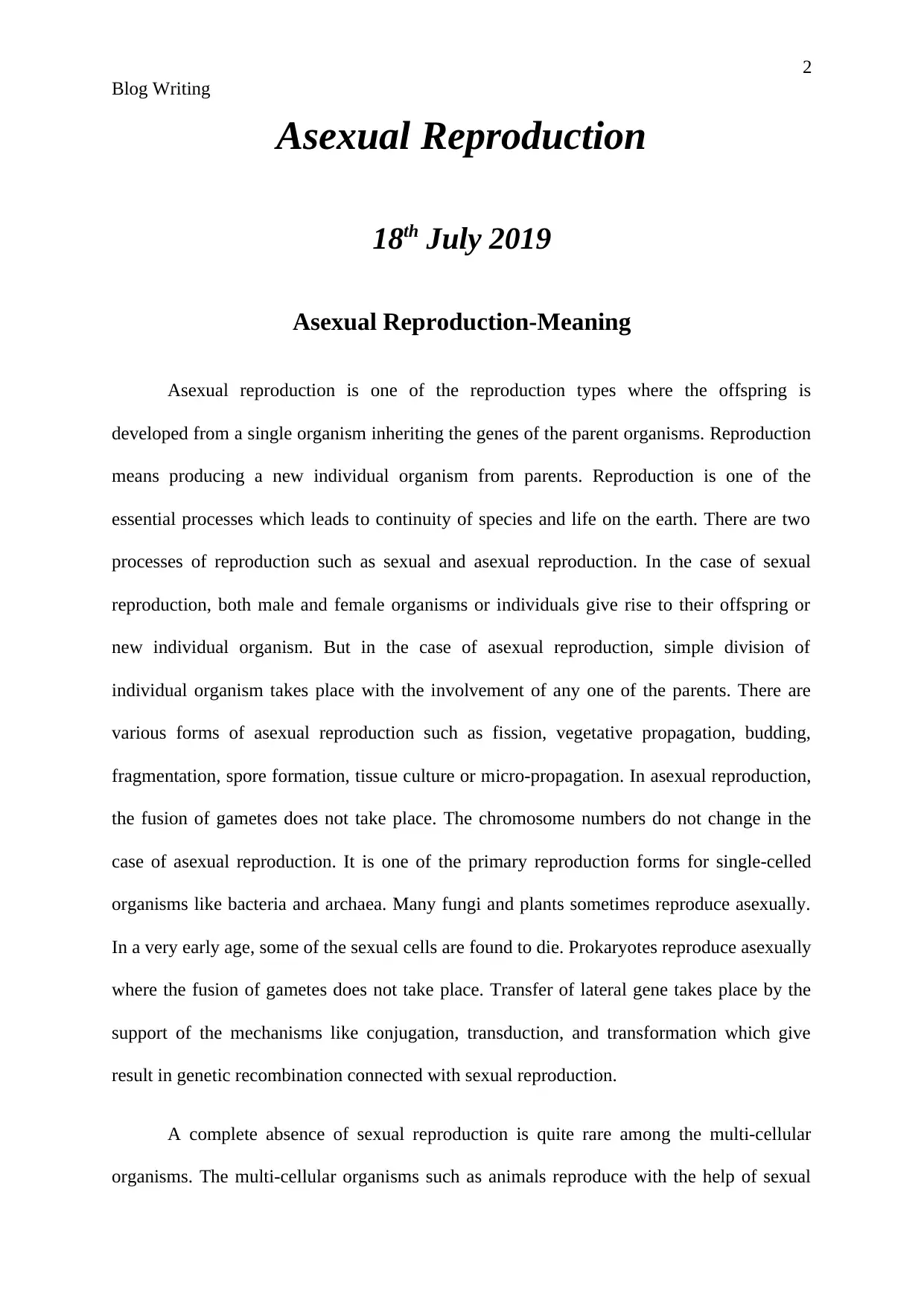
2
Blog Writing
Asexual Reproduction
18th July 2019
Asexual Reproduction-Meaning
Asexual reproduction is one of the reproduction types where the offspring is
developed from a single organism inheriting the genes of the parent organisms. Reproduction
means producing a new individual organism from parents. Reproduction is one of the
essential processes which leads to continuity of species and life on the earth. There are two
processes of reproduction such as sexual and asexual reproduction. In the case of sexual
reproduction, both male and female organisms or individuals give rise to their offspring or
new individual organism. But in the case of asexual reproduction, simple division of
individual organism takes place with the involvement of any one of the parents. There are
various forms of asexual reproduction such as fission, vegetative propagation, budding,
fragmentation, spore formation, tissue culture or micro-propagation. In asexual reproduction,
the fusion of gametes does not take place. The chromosome numbers do not change in the
case of asexual reproduction. It is one of the primary reproduction forms for single-celled
organisms like bacteria and archaea. Many fungi and plants sometimes reproduce asexually.
In a very early age, some of the sexual cells are found to die. Prokaryotes reproduce asexually
where the fusion of gametes does not take place. Transfer of lateral gene takes place by the
support of the mechanisms like conjugation, transduction, and transformation which give
result in genetic recombination connected with sexual reproduction.
A complete absence of sexual reproduction is quite rare among the multi-cellular
organisms. The multi-cellular organisms such as animals reproduce with the help of sexual
Blog Writing
Asexual Reproduction
18th July 2019
Asexual Reproduction-Meaning
Asexual reproduction is one of the reproduction types where the offspring is
developed from a single organism inheriting the genes of the parent organisms. Reproduction
means producing a new individual organism from parents. Reproduction is one of the
essential processes which leads to continuity of species and life on the earth. There are two
processes of reproduction such as sexual and asexual reproduction. In the case of sexual
reproduction, both male and female organisms or individuals give rise to their offspring or
new individual organism. But in the case of asexual reproduction, simple division of
individual organism takes place with the involvement of any one of the parents. There are
various forms of asexual reproduction such as fission, vegetative propagation, budding,
fragmentation, spore formation, tissue culture or micro-propagation. In asexual reproduction,
the fusion of gametes does not take place. The chromosome numbers do not change in the
case of asexual reproduction. It is one of the primary reproduction forms for single-celled
organisms like bacteria and archaea. Many fungi and plants sometimes reproduce asexually.
In a very early age, some of the sexual cells are found to die. Prokaryotes reproduce asexually
where the fusion of gametes does not take place. Transfer of lateral gene takes place by the
support of the mechanisms like conjugation, transduction, and transformation which give
result in genetic recombination connected with sexual reproduction.
A complete absence of sexual reproduction is quite rare among the multi-cellular
organisms. The multi-cellular organisms such as animals reproduce with the help of sexual
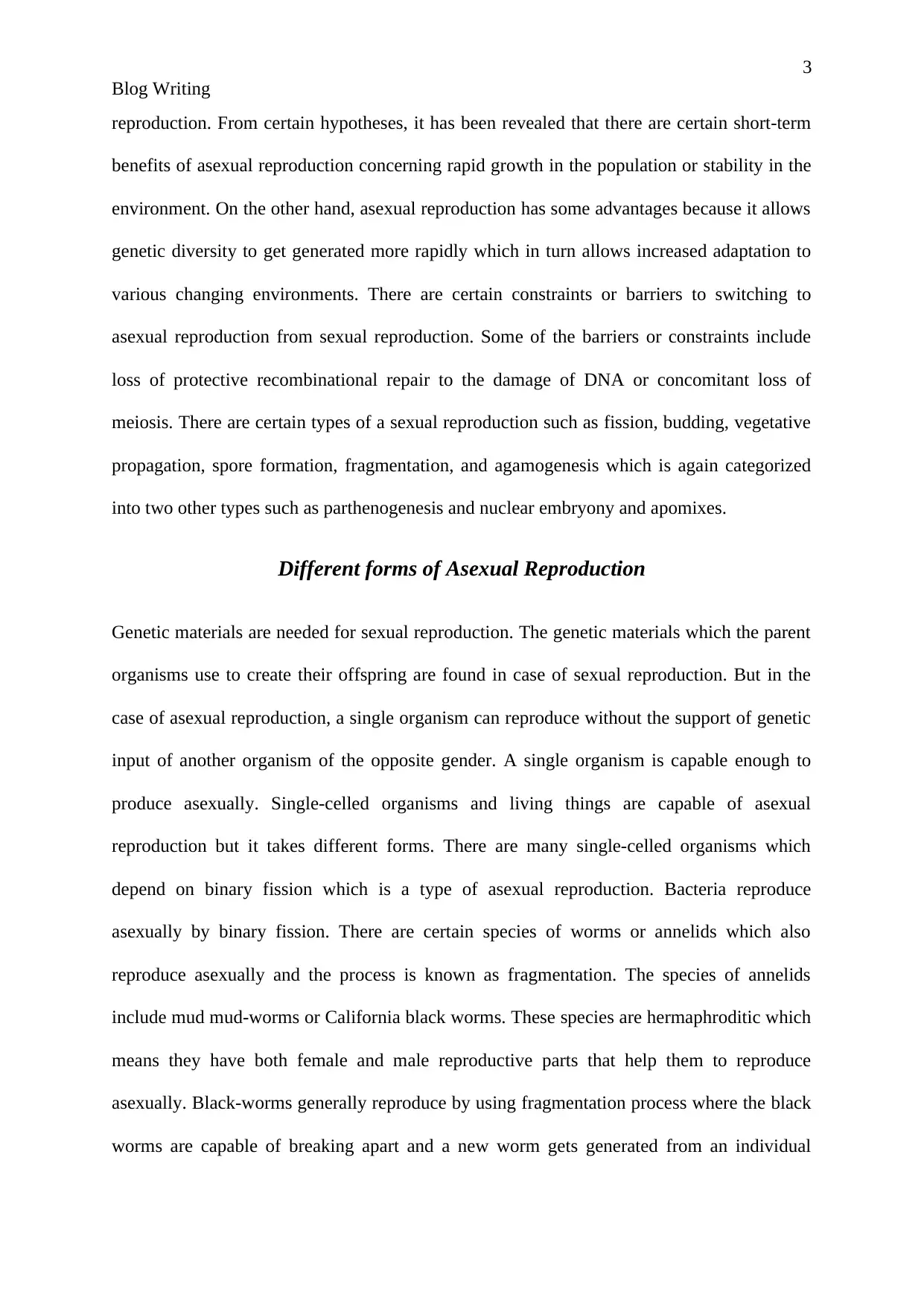
3
Blog Writing
reproduction. From certain hypotheses, it has been revealed that there are certain short-term
benefits of asexual reproduction concerning rapid growth in the population or stability in the
environment. On the other hand, asexual reproduction has some advantages because it allows
genetic diversity to get generated more rapidly which in turn allows increased adaptation to
various changing environments. There are certain constraints or barriers to switching to
asexual reproduction from sexual reproduction. Some of the barriers or constraints include
loss of protective recombinational repair to the damage of DNA or concomitant loss of
meiosis. There are certain types of a sexual reproduction such as fission, budding, vegetative
propagation, spore formation, fragmentation, and agamogenesis which is again categorized
into two other types such as parthenogenesis and nuclear embryony and apomixes.
Different forms of Asexual Reproduction
Genetic materials are needed for sexual reproduction. The genetic materials which the parent
organisms use to create their offspring are found in case of sexual reproduction. But in the
case of asexual reproduction, a single organism can reproduce without the support of genetic
input of another organism of the opposite gender. A single organism is capable enough to
produce asexually. Single-celled organisms and living things are capable of asexual
reproduction but it takes different forms. There are many single-celled organisms which
depend on binary fission which is a type of asexual reproduction. Bacteria reproduce
asexually by binary fission. There are certain species of worms or annelids which also
reproduce asexually and the process is known as fragmentation. The species of annelids
include mud mud-worms or California black worms. These species are hermaphroditic which
means they have both female and male reproductive parts that help them to reproduce
asexually. Black-worms generally reproduce by using fragmentation process where the black
worms are capable of breaking apart and a new worm gets generated from an individual
Blog Writing
reproduction. From certain hypotheses, it has been revealed that there are certain short-term
benefits of asexual reproduction concerning rapid growth in the population or stability in the
environment. On the other hand, asexual reproduction has some advantages because it allows
genetic diversity to get generated more rapidly which in turn allows increased adaptation to
various changing environments. There are certain constraints or barriers to switching to
asexual reproduction from sexual reproduction. Some of the barriers or constraints include
loss of protective recombinational repair to the damage of DNA or concomitant loss of
meiosis. There are certain types of a sexual reproduction such as fission, budding, vegetative
propagation, spore formation, fragmentation, and agamogenesis which is again categorized
into two other types such as parthenogenesis and nuclear embryony and apomixes.
Different forms of Asexual Reproduction
Genetic materials are needed for sexual reproduction. The genetic materials which the parent
organisms use to create their offspring are found in case of sexual reproduction. But in the
case of asexual reproduction, a single organism can reproduce without the support of genetic
input of another organism of the opposite gender. A single organism is capable enough to
produce asexually. Single-celled organisms and living things are capable of asexual
reproduction but it takes different forms. There are many single-celled organisms which
depend on binary fission which is a type of asexual reproduction. Bacteria reproduce
asexually by binary fission. There are certain species of worms or annelids which also
reproduce asexually and the process is known as fragmentation. The species of annelids
include mud mud-worms or California black worms. These species are hermaphroditic which
means they have both female and male reproductive parts that help them to reproduce
asexually. Black-worms generally reproduce by using fragmentation process where the black
worms are capable of breaking apart and a new worm gets generated from an individual
⊘ This is a preview!⊘
Do you want full access?
Subscribe today to unlock all pages.

Trusted by 1+ million students worldwide
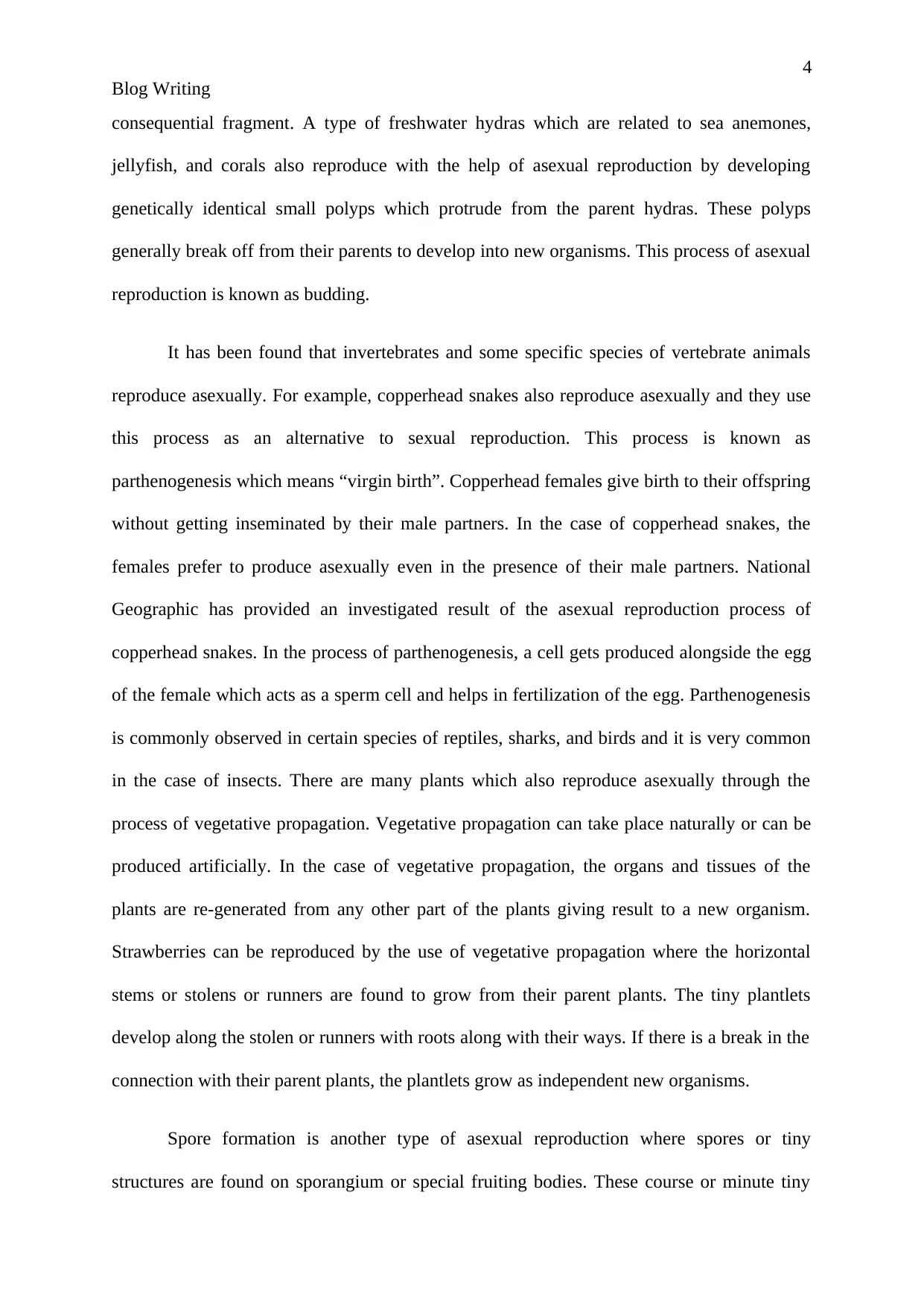
4
Blog Writing
consequential fragment. A type of freshwater hydras which are related to sea anemones,
jellyfish, and corals also reproduce with the help of asexual reproduction by developing
genetically identical small polyps which protrude from the parent hydras. These polyps
generally break off from their parents to develop into new organisms. This process of asexual
reproduction is known as budding.
It has been found that invertebrates and some specific species of vertebrate animals
reproduce asexually. For example, copperhead snakes also reproduce asexually and they use
this process as an alternative to sexual reproduction. This process is known as
parthenogenesis which means “virgin birth”. Copperhead females give birth to their offspring
without getting inseminated by their male partners. In the case of copperhead snakes, the
females prefer to produce asexually even in the presence of their male partners. National
Geographic has provided an investigated result of the asexual reproduction process of
copperhead snakes. In the process of parthenogenesis, a cell gets produced alongside the egg
of the female which acts as a sperm cell and helps in fertilization of the egg. Parthenogenesis
is commonly observed in certain species of reptiles, sharks, and birds and it is very common
in the case of insects. There are many plants which also reproduce asexually through the
process of vegetative propagation. Vegetative propagation can take place naturally or can be
produced artificially. In the case of vegetative propagation, the organs and tissues of the
plants are re-generated from any other part of the plants giving result to a new organism.
Strawberries can be reproduced by the use of vegetative propagation where the horizontal
stems or stolens or runners are found to grow from their parent plants. The tiny plantlets
develop along the stolen or runners with roots along with their ways. If there is a break in the
connection with their parent plants, the plantlets grow as independent new organisms.
Spore formation is another type of asexual reproduction where spores or tiny
structures are found on sporangium or special fruiting bodies. These course or minute tiny
Blog Writing
consequential fragment. A type of freshwater hydras which are related to sea anemones,
jellyfish, and corals also reproduce with the help of asexual reproduction by developing
genetically identical small polyps which protrude from the parent hydras. These polyps
generally break off from their parents to develop into new organisms. This process of asexual
reproduction is known as budding.
It has been found that invertebrates and some specific species of vertebrate animals
reproduce asexually. For example, copperhead snakes also reproduce asexually and they use
this process as an alternative to sexual reproduction. This process is known as
parthenogenesis which means “virgin birth”. Copperhead females give birth to their offspring
without getting inseminated by their male partners. In the case of copperhead snakes, the
females prefer to produce asexually even in the presence of their male partners. National
Geographic has provided an investigated result of the asexual reproduction process of
copperhead snakes. In the process of parthenogenesis, a cell gets produced alongside the egg
of the female which acts as a sperm cell and helps in fertilization of the egg. Parthenogenesis
is commonly observed in certain species of reptiles, sharks, and birds and it is very common
in the case of insects. There are many plants which also reproduce asexually through the
process of vegetative propagation. Vegetative propagation can take place naturally or can be
produced artificially. In the case of vegetative propagation, the organs and tissues of the
plants are re-generated from any other part of the plants giving result to a new organism.
Strawberries can be reproduced by the use of vegetative propagation where the horizontal
stems or stolens or runners are found to grow from their parent plants. The tiny plantlets
develop along the stolen or runners with roots along with their ways. If there is a break in the
connection with their parent plants, the plantlets grow as independent new organisms.
Spore formation is another type of asexual reproduction where spores or tiny
structures are found on sporangium or special fruiting bodies. These course or minute tiny
Paraphrase This Document
Need a fresh take? Get an instant paraphrase of this document with our AI Paraphraser
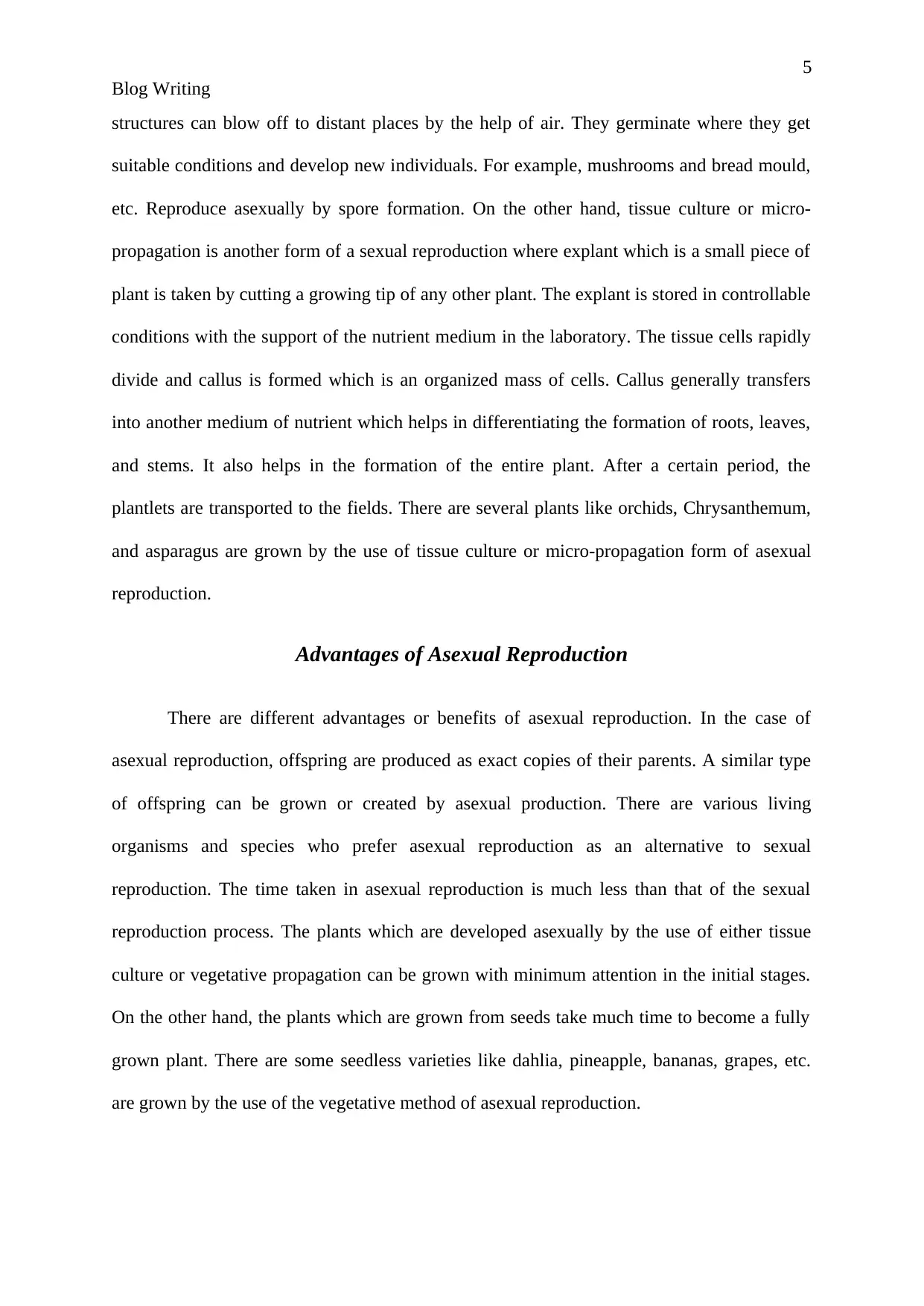
5
Blog Writing
structures can blow off to distant places by the help of air. They germinate where they get
suitable conditions and develop new individuals. For example, mushrooms and bread mould,
etc. Reproduce asexually by spore formation. On the other hand, tissue culture or micro-
propagation is another form of a sexual reproduction where explant which is a small piece of
plant is taken by cutting a growing tip of any other plant. The explant is stored in controllable
conditions with the support of the nutrient medium in the laboratory. The tissue cells rapidly
divide and callus is formed which is an organized mass of cells. Callus generally transfers
into another medium of nutrient which helps in differentiating the formation of roots, leaves,
and stems. It also helps in the formation of the entire plant. After a certain period, the
plantlets are transported to the fields. There are several plants like orchids, Chrysanthemum,
and asparagus are grown by the use of tissue culture or micro-propagation form of asexual
reproduction.
Advantages of Asexual Reproduction
There are different advantages or benefits of asexual reproduction. In the case of
asexual reproduction, offspring are produced as exact copies of their parents. A similar type
of offspring can be grown or created by asexual production. There are various living
organisms and species who prefer asexual reproduction as an alternative to sexual
reproduction. The time taken in asexual reproduction is much less than that of the sexual
reproduction process. The plants which are developed asexually by the use of either tissue
culture or vegetative propagation can be grown with minimum attention in the initial stages.
On the other hand, the plants which are grown from seeds take much time to become a fully
grown plant. There are some seedless varieties like dahlia, pineapple, bananas, grapes, etc.
are grown by the use of the vegetative method of asexual reproduction.
Blog Writing
structures can blow off to distant places by the help of air. They germinate where they get
suitable conditions and develop new individuals. For example, mushrooms and bread mould,
etc. Reproduce asexually by spore formation. On the other hand, tissue culture or micro-
propagation is another form of a sexual reproduction where explant which is a small piece of
plant is taken by cutting a growing tip of any other plant. The explant is stored in controllable
conditions with the support of the nutrient medium in the laboratory. The tissue cells rapidly
divide and callus is formed which is an organized mass of cells. Callus generally transfers
into another medium of nutrient which helps in differentiating the formation of roots, leaves,
and stems. It also helps in the formation of the entire plant. After a certain period, the
plantlets are transported to the fields. There are several plants like orchids, Chrysanthemum,
and asparagus are grown by the use of tissue culture or micro-propagation form of asexual
reproduction.
Advantages of Asexual Reproduction
There are different advantages or benefits of asexual reproduction. In the case of
asexual reproduction, offspring are produced as exact copies of their parents. A similar type
of offspring can be grown or created by asexual production. There are various living
organisms and species who prefer asexual reproduction as an alternative to sexual
reproduction. The time taken in asexual reproduction is much less than that of the sexual
reproduction process. The plants which are developed asexually by the use of either tissue
culture or vegetative propagation can be grown with minimum attention in the initial stages.
On the other hand, the plants which are grown from seeds take much time to become a fully
grown plant. There are some seedless varieties like dahlia, pineapple, bananas, grapes, etc.
are grown by the use of the vegetative method of asexual reproduction.
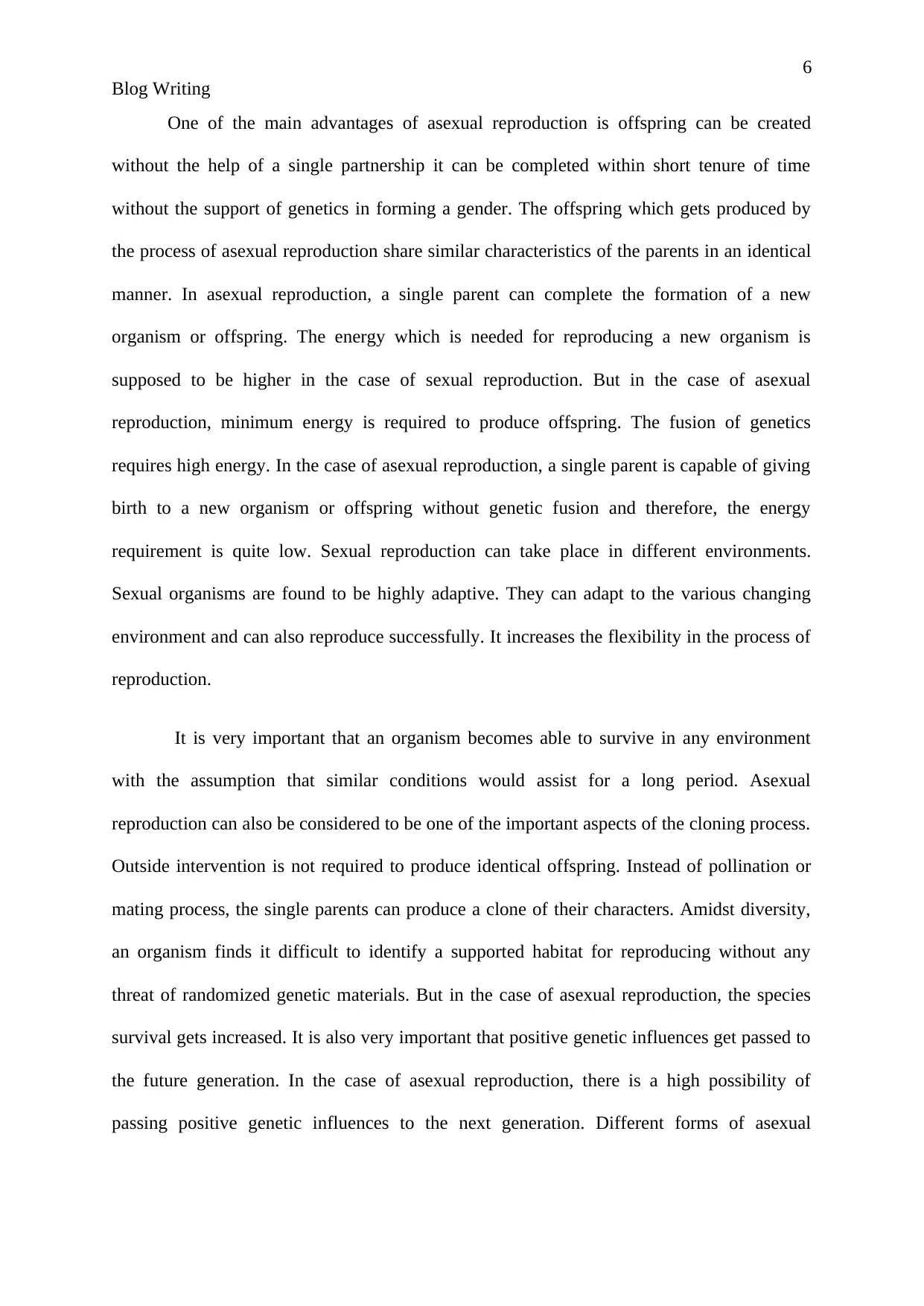
6
Blog Writing
One of the main advantages of asexual reproduction is offspring can be created
without the help of a single partnership it can be completed within short tenure of time
without the support of genetics in forming a gender. The offspring which gets produced by
the process of asexual reproduction share similar characteristics of the parents in an identical
manner. In asexual reproduction, a single parent can complete the formation of a new
organism or offspring. The energy which is needed for reproducing a new organism is
supposed to be higher in the case of sexual reproduction. But in the case of asexual
reproduction, minimum energy is required to produce offspring. The fusion of genetics
requires high energy. In the case of asexual reproduction, a single parent is capable of giving
birth to a new organism or offspring without genetic fusion and therefore, the energy
requirement is quite low. Sexual reproduction can take place in different environments.
Sexual organisms are found to be highly adaptive. They can adapt to the various changing
environment and can also reproduce successfully. It increases the flexibility in the process of
reproduction.
It is very important that an organism becomes able to survive in any environment
with the assumption that similar conditions would assist for a long period. Asexual
reproduction can also be considered to be one of the important aspects of the cloning process.
Outside intervention is not required to produce identical offspring. Instead of pollination or
mating process, the single parents can produce a clone of their characters. Amidst diversity,
an organism finds it difficult to identify a supported habitat for reproducing without any
threat of randomized genetic materials. But in the case of asexual reproduction, the species
survival gets increased. It is also very important that positive genetic influences get passed to
the future generation. In the case of asexual reproduction, there is a high possibility of
passing positive genetic influences to the next generation. Different forms of asexual
Blog Writing
One of the main advantages of asexual reproduction is offspring can be created
without the help of a single partnership it can be completed within short tenure of time
without the support of genetics in forming a gender. The offspring which gets produced by
the process of asexual reproduction share similar characteristics of the parents in an identical
manner. In asexual reproduction, a single parent can complete the formation of a new
organism or offspring. The energy which is needed for reproducing a new organism is
supposed to be higher in the case of sexual reproduction. But in the case of asexual
reproduction, minimum energy is required to produce offspring. The fusion of genetics
requires high energy. In the case of asexual reproduction, a single parent is capable of giving
birth to a new organism or offspring without genetic fusion and therefore, the energy
requirement is quite low. Sexual reproduction can take place in different environments.
Sexual organisms are found to be highly adaptive. They can adapt to the various changing
environment and can also reproduce successfully. It increases the flexibility in the process of
reproduction.
It is very important that an organism becomes able to survive in any environment
with the assumption that similar conditions would assist for a long period. Asexual
reproduction can also be considered to be one of the important aspects of the cloning process.
Outside intervention is not required to produce identical offspring. Instead of pollination or
mating process, the single parents can produce a clone of their characters. Amidst diversity,
an organism finds it difficult to identify a supported habitat for reproducing without any
threat of randomized genetic materials. But in the case of asexual reproduction, the species
survival gets increased. It is also very important that positive genetic influences get passed to
the future generation. In the case of asexual reproduction, there is a high possibility of
passing positive genetic influences to the next generation. Different forms of asexual
⊘ This is a preview!⊘
Do you want full access?
Subscribe today to unlock all pages.

Trusted by 1+ million students worldwide
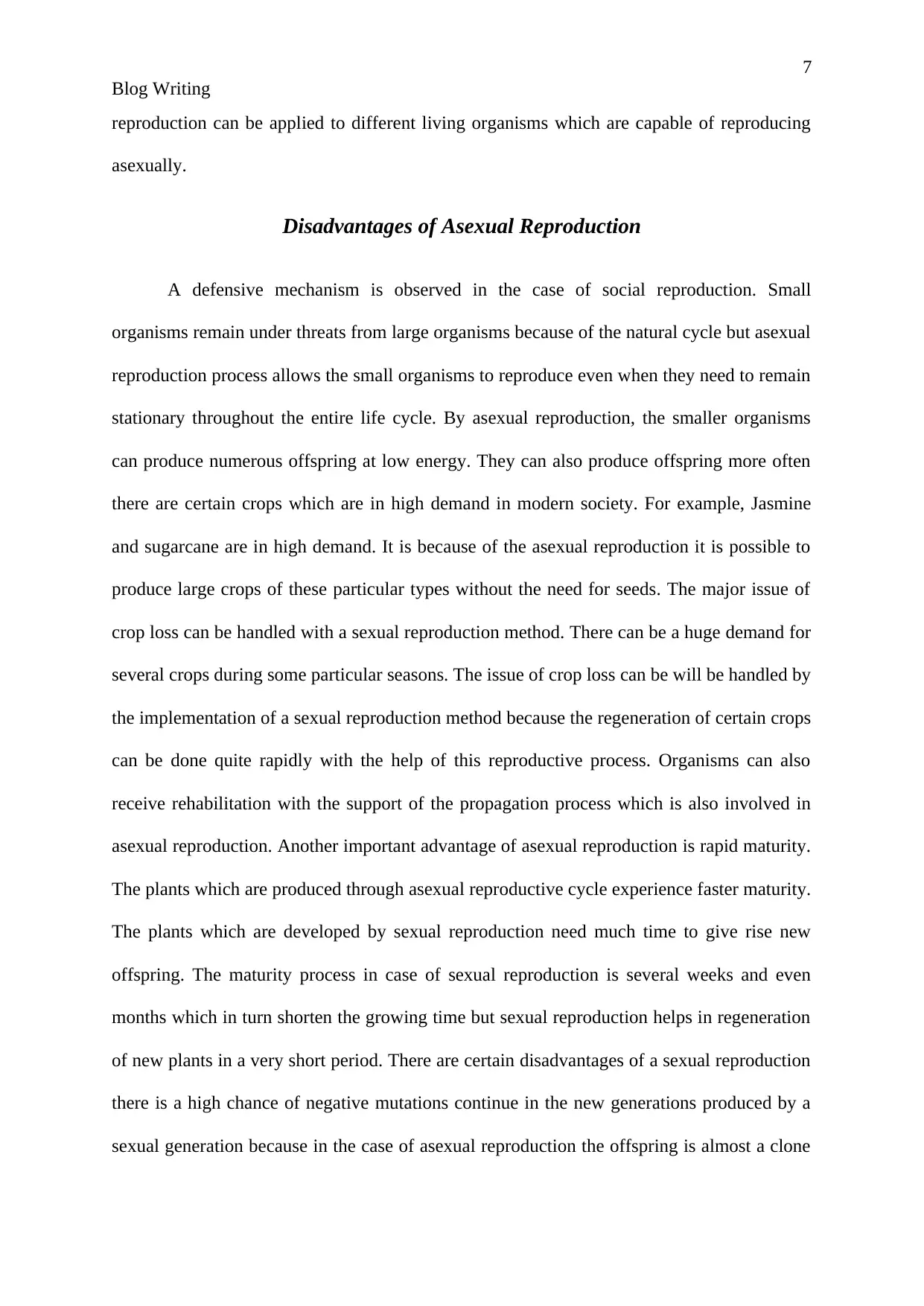
7
Blog Writing
reproduction can be applied to different living organisms which are capable of reproducing
asexually.
Disadvantages of Asexual Reproduction
A defensive mechanism is observed in the case of social reproduction. Small
organisms remain under threats from large organisms because of the natural cycle but asexual
reproduction process allows the small organisms to reproduce even when they need to remain
stationary throughout the entire life cycle. By asexual reproduction, the smaller organisms
can produce numerous offspring at low energy. They can also produce offspring more often
there are certain crops which are in high demand in modern society. For example, Jasmine
and sugarcane are in high demand. It is because of the asexual reproduction it is possible to
produce large crops of these particular types without the need for seeds. The major issue of
crop loss can be handled with a sexual reproduction method. There can be a huge demand for
several crops during some particular seasons. The issue of crop loss can be will be handled by
the implementation of a sexual reproduction method because the regeneration of certain crops
can be done quite rapidly with the help of this reproductive process. Organisms can also
receive rehabilitation with the support of the propagation process which is also involved in
asexual reproduction. Another important advantage of asexual reproduction is rapid maturity.
The plants which are produced through asexual reproductive cycle experience faster maturity.
The plants which are developed by sexual reproduction need much time to give rise new
offspring. The maturity process in case of sexual reproduction is several weeks and even
months which in turn shorten the growing time but sexual reproduction helps in regeneration
of new plants in a very short period. There are certain disadvantages of a sexual reproduction
there is a high chance of negative mutations continue in the new generations produced by a
sexual generation because in the case of asexual reproduction the offspring is almost a clone
Blog Writing
reproduction can be applied to different living organisms which are capable of reproducing
asexually.
Disadvantages of Asexual Reproduction
A defensive mechanism is observed in the case of social reproduction. Small
organisms remain under threats from large organisms because of the natural cycle but asexual
reproduction process allows the small organisms to reproduce even when they need to remain
stationary throughout the entire life cycle. By asexual reproduction, the smaller organisms
can produce numerous offspring at low energy. They can also produce offspring more often
there are certain crops which are in high demand in modern society. For example, Jasmine
and sugarcane are in high demand. It is because of the asexual reproduction it is possible to
produce large crops of these particular types without the need for seeds. The major issue of
crop loss can be handled with a sexual reproduction method. There can be a huge demand for
several crops during some particular seasons. The issue of crop loss can be will be handled by
the implementation of a sexual reproduction method because the regeneration of certain crops
can be done quite rapidly with the help of this reproductive process. Organisms can also
receive rehabilitation with the support of the propagation process which is also involved in
asexual reproduction. Another important advantage of asexual reproduction is rapid maturity.
The plants which are produced through asexual reproductive cycle experience faster maturity.
The plants which are developed by sexual reproduction need much time to give rise new
offspring. The maturity process in case of sexual reproduction is several weeks and even
months which in turn shorten the growing time but sexual reproduction helps in regeneration
of new plants in a very short period. There are certain disadvantages of a sexual reproduction
there is a high chance of negative mutations continue in the new generations produced by a
sexual generation because in the case of asexual reproduction the offspring is almost a clone
Paraphrase This Document
Need a fresh take? Get an instant paraphrase of this document with our AI Paraphraser
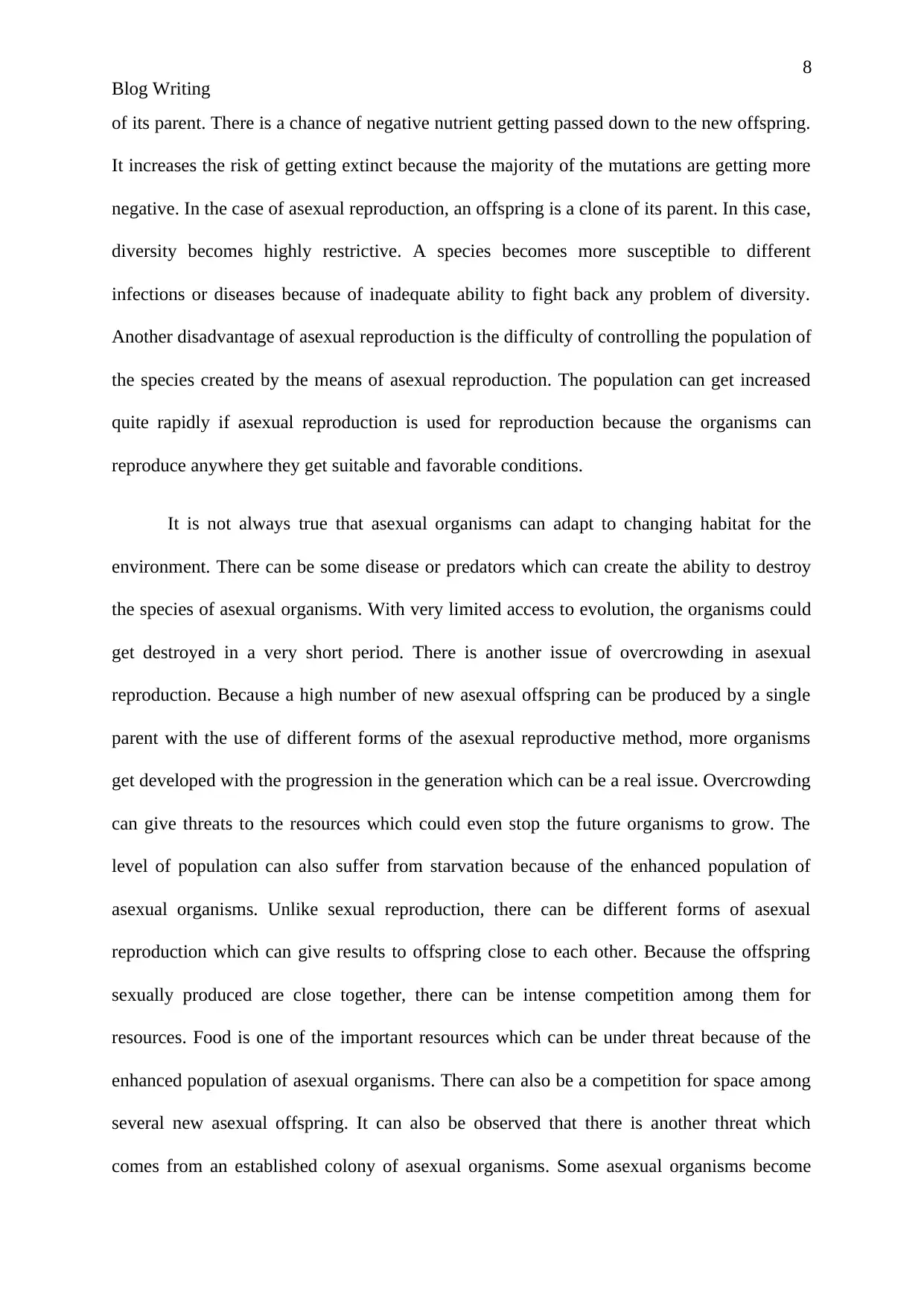
8
Blog Writing
of its parent. There is a chance of negative nutrient getting passed down to the new offspring.
It increases the risk of getting extinct because the majority of the mutations are getting more
negative. In the case of asexual reproduction, an offspring is a clone of its parent. In this case,
diversity becomes highly restrictive. A species becomes more susceptible to different
infections or diseases because of inadequate ability to fight back any problem of diversity.
Another disadvantage of asexual reproduction is the difficulty of controlling the population of
the species created by the means of asexual reproduction. The population can get increased
quite rapidly if asexual reproduction is used for reproduction because the organisms can
reproduce anywhere they get suitable and favorable conditions.
It is not always true that asexual organisms can adapt to changing habitat for the
environment. There can be some disease or predators which can create the ability to destroy
the species of asexual organisms. With very limited access to evolution, the organisms could
get destroyed in a very short period. There is another issue of overcrowding in asexual
reproduction. Because a high number of new asexual offspring can be produced by a single
parent with the use of different forms of the asexual reproductive method, more organisms
get developed with the progression in the generation which can be a real issue. Overcrowding
can give threats to the resources which could even stop the future organisms to grow. The
level of population can also suffer from starvation because of the enhanced population of
asexual organisms. Unlike sexual reproduction, there can be different forms of asexual
reproduction which can give results to offspring close to each other. Because the offspring
sexually produced are close together, there can be intense competition among them for
resources. Food is one of the important resources which can be under threat because of the
enhanced population of asexual organisms. There can also be a competition for space among
several new asexual offspring. It can also be observed that there is another threat which
comes from an established colony of asexual organisms. Some asexual organisms become
Blog Writing
of its parent. There is a chance of negative nutrient getting passed down to the new offspring.
It increases the risk of getting extinct because the majority of the mutations are getting more
negative. In the case of asexual reproduction, an offspring is a clone of its parent. In this case,
diversity becomes highly restrictive. A species becomes more susceptible to different
infections or diseases because of inadequate ability to fight back any problem of diversity.
Another disadvantage of asexual reproduction is the difficulty of controlling the population of
the species created by the means of asexual reproduction. The population can get increased
quite rapidly if asexual reproduction is used for reproduction because the organisms can
reproduce anywhere they get suitable and favorable conditions.
It is not always true that asexual organisms can adapt to changing habitat for the
environment. There can be some disease or predators which can create the ability to destroy
the species of asexual organisms. With very limited access to evolution, the organisms could
get destroyed in a very short period. There is another issue of overcrowding in asexual
reproduction. Because a high number of new asexual offspring can be produced by a single
parent with the use of different forms of the asexual reproductive method, more organisms
get developed with the progression in the generation which can be a real issue. Overcrowding
can give threats to the resources which could even stop the future organisms to grow. The
level of population can also suffer from starvation because of the enhanced population of
asexual organisms. Unlike sexual reproduction, there can be different forms of asexual
reproduction which can give results to offspring close to each other. Because the offspring
sexually produced are close together, there can be intense competition among them for
resources. Food is one of the important resources which can be under threat because of the
enhanced population of asexual organisms. There can also be a competition for space among
several new asexual offspring. It can also be observed that there is another threat which
comes from an established colony of asexual organisms. Some asexual organisms become
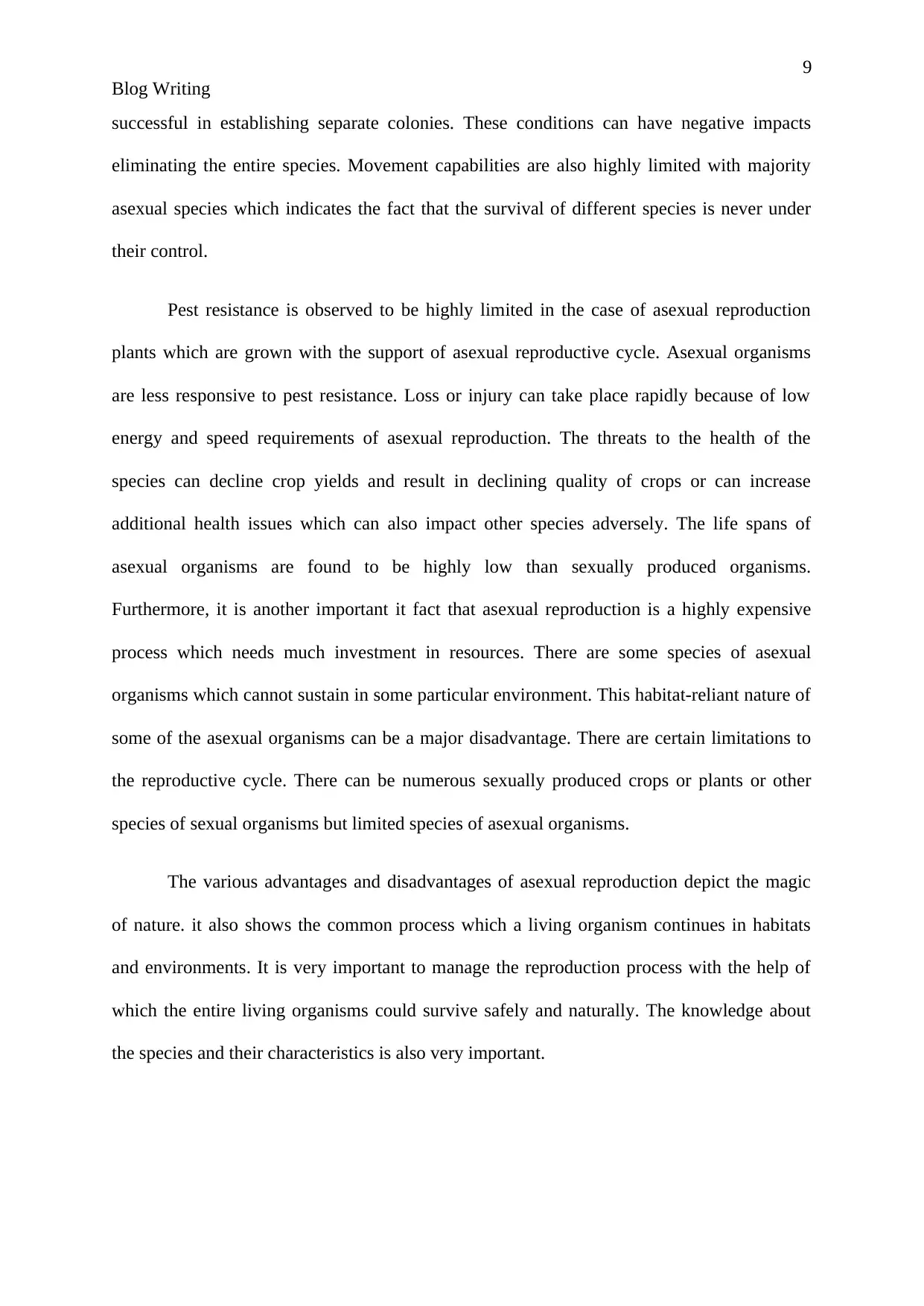
9
Blog Writing
successful in establishing separate colonies. These conditions can have negative impacts
eliminating the entire species. Movement capabilities are also highly limited with majority
asexual species which indicates the fact that the survival of different species is never under
their control.
Pest resistance is observed to be highly limited in the case of asexual reproduction
plants which are grown with the support of asexual reproductive cycle. Asexual organisms
are less responsive to pest resistance. Loss or injury can take place rapidly because of low
energy and speed requirements of asexual reproduction. The threats to the health of the
species can decline crop yields and result in declining quality of crops or can increase
additional health issues which can also impact other species adversely. The life spans of
asexual organisms are found to be highly low than sexually produced organisms.
Furthermore, it is another important it fact that asexual reproduction is a highly expensive
process which needs much investment in resources. There are some species of asexual
organisms which cannot sustain in some particular environment. This habitat-reliant nature of
some of the asexual organisms can be a major disadvantage. There are certain limitations to
the reproductive cycle. There can be numerous sexually produced crops or plants or other
species of sexual organisms but limited species of asexual organisms.
The various advantages and disadvantages of asexual reproduction depict the magic
of nature. it also shows the common process which a living organism continues in habitats
and environments. It is very important to manage the reproduction process with the help of
which the entire living organisms could survive safely and naturally. The knowledge about
the species and their characteristics is also very important.
Blog Writing
successful in establishing separate colonies. These conditions can have negative impacts
eliminating the entire species. Movement capabilities are also highly limited with majority
asexual species which indicates the fact that the survival of different species is never under
their control.
Pest resistance is observed to be highly limited in the case of asexual reproduction
plants which are grown with the support of asexual reproductive cycle. Asexual organisms
are less responsive to pest resistance. Loss or injury can take place rapidly because of low
energy and speed requirements of asexual reproduction. The threats to the health of the
species can decline crop yields and result in declining quality of crops or can increase
additional health issues which can also impact other species adversely. The life spans of
asexual organisms are found to be highly low than sexually produced organisms.
Furthermore, it is another important it fact that asexual reproduction is a highly expensive
process which needs much investment in resources. There are some species of asexual
organisms which cannot sustain in some particular environment. This habitat-reliant nature of
some of the asexual organisms can be a major disadvantage. There are certain limitations to
the reproductive cycle. There can be numerous sexually produced crops or plants or other
species of sexual organisms but limited species of asexual organisms.
The various advantages and disadvantages of asexual reproduction depict the magic
of nature. it also shows the common process which a living organism continues in habitats
and environments. It is very important to manage the reproduction process with the help of
which the entire living organisms could survive safely and naturally. The knowledge about
the species and their characteristics is also very important.
⊘ This is a preview!⊘
Do you want full access?
Subscribe today to unlock all pages.

Trusted by 1+ million students worldwide
1 out of 9
Your All-in-One AI-Powered Toolkit for Academic Success.
+13062052269
info@desklib.com
Available 24*7 on WhatsApp / Email
![[object Object]](/_next/static/media/star-bottom.7253800d.svg)
Unlock your academic potential
Copyright © 2020–2025 A2Z Services. All Rights Reserved. Developed and managed by ZUCOL.

